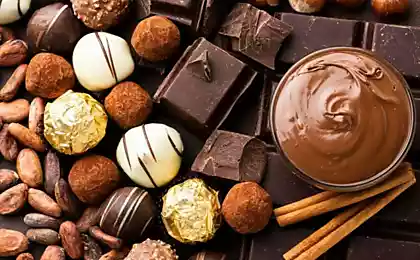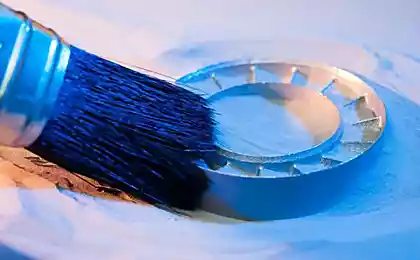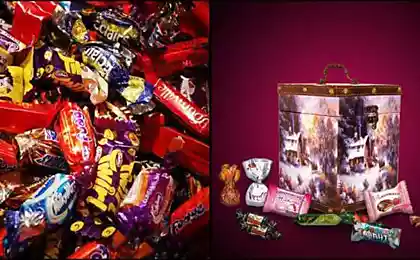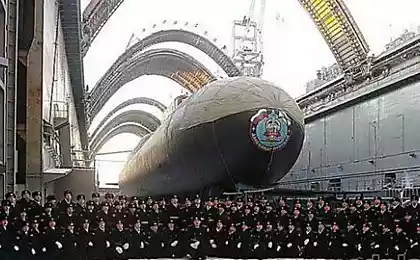697
What candy or what not tell label confectionery products?
Department of confectionery for many — the most favourite place in the store. We go there in search of something tasty to indulge in a chocolate or candy, buy a cake or cakes for the holiday, and perhaps to indulge the child.
Fifty one million four hundred fifty thousand eight hundred thirty six
The inspection conducted by experts of the Roskontrol, showed that pastry is one of those product categories, and labels that need to be studied particularly carefully. Otherwise you risk to be disappointed in your purchase, and even to endanger their own health and the health of their loved ones.
What candy?
Favorite "Squirrel", "Red riding hood" and "Bears in the North" is familiar to all from childhood, and we habitually trust them. In the USSR they were made according to GOST, and if you bought candy of a certain name, you always know what will be the taste. Modern manufacturers have cleverly used this trust. Many friends we have candy for the last 30-40 years has changed significantly. In order to reduce their cost, cocoa butter substitute cheaper palm or palm kernel oil (often hydrogenated fats containing TRANS-isomers of fatty acids), added emulsifiers, antioxidants and artificial flavors. Confectioneries skillfully using the achievements of food chemistry.
Here, for example, the composition of chocolates "Mask" production "Rotfront»:
Sugar, chocolate glaze (sugar, cocoa mass, equivalent of cocoa butter, cocoa powder, emulsifiers E322, Е476, flavor identical to natural "vanilla"), cocoa butter substitute, grated peanuts, dry whole milk powder, flour, soybean deodorized, cocoa powder, antioxidant E300, flavouring identical to natural "Vanilla".
And this is "Kara-Kum" confectionery factory "Red October»:
Ingredients: sugar, chocolate glaze (sugar, cocoa mass, equivalent of cocoa butter, cocoa powder, emulsifiers (E322, Е476), flavor identical to natural "Vanilla"), cocoa mass, almond kernel mass, cocoa butter, crushed wafers, milk fat substitute (vegetable), grated peanut, antioxidant E300, flavouring identical to natural "Vanilla", emulsifier E322.
That is, find the 10 differences. And these chocolates contain vegetable fats, emulsifiers and flavours.
By the way, to read the part of the candy before purchasing it is practically impossible. Most often they are sold by weight, and wrapper one particular candy really little space to place the mandatory information on the composition, protein, fat, calories, and so on. In fact, some of the information can be found on the edge of the wrapper, but to read it, you need to open candy. Or ask the seller to show the label pasted on the transport packaging — a box of chocolates.
This applies to almost all candy sold by weight. And cheap colored Lollipops candy Roshen confectionery factory "Roshen", and to expensive chocolates on the basis of fruits and nuts "Coconut" and "Prunes" from Micaello.
Particularly distinguished "Capital stuff" (LLC "MOK-Proizvodstvo": the wrapper of the candy is no information about the product, except for brands and taste — the nougat with cranberries. Apparently, the manufacturer decided that is all we need to know.
However, formally a violation of this marking of chocolates is not. It is expected that the product this seller (and sometimes the buyer) is weighed and placed on a package label with all the data. It is hoped that the text of this label store completely takes all the necessary data from the box.
Baby joy
One of the most popular children's sweets — "Kinder surprise" (producer JSC "Ferrero Russi"). Important consumer information on the composition hidden in the folds of the foil package, and you can read it, only straightened the foil. That, again, expand in the store and, in fact, to spoil the product?
But after opening the package (if you manage not to break), you can at least read the part.
On the packaging of the other children's "surprise" sugar plum "Smeshariki" ("Sweetexim") font is so small that to read the text is simply unrealistic. To be clear: the font size of the text you are now reading was 10.5 points. Now imagine the font size of 3 points! This font written composition and nutrient values of the product.
We took pictures of the packaging of "Smeshariki" on the big screen monitor could read the ingredients: sugar, maltodextrin, glucose syrup, flowing agent, acidity regulator, flavourings, colourings.
Practically, the sweetness of my sugar and food additives. Now I understand why the font is so small. Such composition is better not to read.
Sugar dragees Angry Birds (ZAO "Elysium") is practically a twin of "Smeshariki". Again a font size less than 3 points, and even placed the information on the deformed shrink film, and certain elements of the text to read is simply impossible.
Similar problem chocolate products Chupa-Chups: data located in the folds of the foil, and read them before buying will not work.
Better not to know?
In the folds of the packaging material hidden from the eyes of consumers product data and manufacturers of cakes "7 days Cake Bar". Before opening the package to read the composition again is unrealistic. And in this case, it is not a commodity sold by weight, and a stand-alone product in consumer packaging with your bar code. And if the consumer can not read the part before opening the package, it is a violation of the technical regulations TR CU 022/2011.
Importantly, the composition of the cupcake is not harmless: it contains hydrogenated fats, which damage to the body is proven and confirmed, and ethyl alcohol, prohibited for children.
However, the product is not positioned as children.
Unlike cookies "Super-kontik" of JSC "Conti-Rus". The weld on the package is made in such a way that the product can be read is that in the Kazakh language. In Russian it is written in the beginning of the list, respectively, located at the very top, under the fold of the package. The product packaging is quite big, and it was quite possible to place the information in a convenient for consumers. Instead, the manufacturer chose on the front side of the label is to place a beautiful picture and composition to write in small print where it is not visible. Note that cookies have hydrogenated fats that are used in the manufacture of children's products.
Has surprised experts and brand products Fineti — "Paste from hazelnuts with cocoa and wheat sticks". Data on the composition and nutritional value is, and even the font readable, but just one problem — the text in English. To read the same in Russian, you need to pass a quest: to pay for the goods at the checkout, open the lid and retrieve a toy. But if the part you don't like? The manufacturer apparently doesn't matter. You've already paid for the purchase.
Caution — the colors!
Few know that in the sweets that we buy children, can be dangerous dyes. As a result of scientific studies have shown that dyes azorubin (Е122), quinoline yellow (E104), yellow "sunset" FCF (E110), red charming AC (E129), Ponceau 4R (E124) and tartrazine (E102) can cause attention deficit and hyperactivity disorder (ADHD) in children. Children who frequently eat foods containing these dyes, become overly active, can't concentrate, to focus, accordingly, worse in school, bad at remembering information.
That is why in the technical regulations of the Customs Union TR CU 022/2011 "Food products in part of its marking" there is a requirement that manufacturers are required to put on the label a warning label on these dyes: "contains dye (dye), which can have a negative effect on activity and attention in children".
Experts have identified several foods that contain these dyes, and no warning labels were not:
Candy You Mix: bean "milk chocolate glaze" and "spaghetti strawberry" production of confectionery factory "Zolotaya Rus". In pills 4 out of 6 of the above dyes, in a "spaghetti" — single (red E129).
Candy Woogie, TD "Carabus". The label says only that the product contains some dyes, but what is the manufacturer of hid. Among them could be the ones which are included in the list of unsafe.
Cotton candy "Happy children" was also "tinted" artificial dyes. The composition is "food coloring-flavoring for making candy floss "Flossine". From publicly available information on the Internet we know that this comprehensive Supplement contains dyes E102 (tartrazine), E110 (yellow "a sunset) and E129 (red charming). No warning signs, alas, no, although the product is clearly positioned as a children's.
Pseudo-baby products
Many manufacturers use various tricks to give their products for children.
Here, for example, "Butter" waffles of production of JSC "Volzhsky Pekar". On the label a child's drawing with a picture of a child and the words "As a child!". This design gives consumers the impression that the product is suitable for children. In fact, these wafers also contain the already mentioned us hydrogenated fats that are used in the manufacture of children's products.
On the packaging of the cookies with raisins "ozbi Family" from the Ostankino factory of dry baked and confectionary goods, we see a happy family and a child that eats these cookies. Composition in addition to hydrogenated fats — preservative sorbic acid, which are not allowed in the diet of children.
Another pseudo-children's product — wafers with fatty fillings "Artek". Information on the composition printed black font on a dark blue background, and the composition again harmful hydrogenated fats.
The label "Butter" toffee from KF "Hope" also depicts a the child, and gives the false impression that this is a children's product. But it isn't margarine.
Attention: the products, including biscuits, designed for young kids, look in the baby food Department
If in the candy Department, you'll see a product whose label depicts a child, it does not mean that the product is possible to buy the children! The label specialized products for children definitely, there is a corresponding inscription — "the product for baby food" — as the requirements for children's products.
And for dessert
On the shelf cakes, we also found a pseudo-children's product — cake "Sweet zoo Monkey" "we Palycha." The name and design of the cake suggests that it for children, but it is not so: he, too, must have for children is a preservative.
Other manufacturers of cakes, too, are paying more attention to the form than the content. The composition attractive cake "Leningrad" (MK "kit", JSC "Tallinn LD") is almost impossible to read the information printed in very small illegible font and partially sealed with an additional label.
Same problem with label cake "Anthill" Mirel. Moreover, part composition is hidden under the sticker with the expiration date, and data is printed in black font on a brown background.published
P. S. And remember, only by changing their consumption — together we change the world! ©
Source: russkievesti.ru/novosti/zdorove/pyatnichnoe.-o-chem-ne-rasskazhut-etiketki-konditerskix-izdelij.html
Fifty one million four hundred fifty thousand eight hundred thirty six
The inspection conducted by experts of the Roskontrol, showed that pastry is one of those product categories, and labels that need to be studied particularly carefully. Otherwise you risk to be disappointed in your purchase, and even to endanger their own health and the health of their loved ones.
What candy?
Favorite "Squirrel", "Red riding hood" and "Bears in the North" is familiar to all from childhood, and we habitually trust them. In the USSR they were made according to GOST, and if you bought candy of a certain name, you always know what will be the taste. Modern manufacturers have cleverly used this trust. Many friends we have candy for the last 30-40 years has changed significantly. In order to reduce their cost, cocoa butter substitute cheaper palm or palm kernel oil (often hydrogenated fats containing TRANS-isomers of fatty acids), added emulsifiers, antioxidants and artificial flavors. Confectioneries skillfully using the achievements of food chemistry.
Here, for example, the composition of chocolates "Mask" production "Rotfront»:
Sugar, chocolate glaze (sugar, cocoa mass, equivalent of cocoa butter, cocoa powder, emulsifiers E322, Е476, flavor identical to natural "vanilla"), cocoa butter substitute, grated peanuts, dry whole milk powder, flour, soybean deodorized, cocoa powder, antioxidant E300, flavouring identical to natural "Vanilla".
And this is "Kara-Kum" confectionery factory "Red October»:
Ingredients: sugar, chocolate glaze (sugar, cocoa mass, equivalent of cocoa butter, cocoa powder, emulsifiers (E322, Е476), flavor identical to natural "Vanilla"), cocoa mass, almond kernel mass, cocoa butter, crushed wafers, milk fat substitute (vegetable), grated peanut, antioxidant E300, flavouring identical to natural "Vanilla", emulsifier E322.
That is, find the 10 differences. And these chocolates contain vegetable fats, emulsifiers and flavours.
By the way, to read the part of the candy before purchasing it is practically impossible. Most often they are sold by weight, and wrapper one particular candy really little space to place the mandatory information on the composition, protein, fat, calories, and so on. In fact, some of the information can be found on the edge of the wrapper, but to read it, you need to open candy. Or ask the seller to show the label pasted on the transport packaging — a box of chocolates.
This applies to almost all candy sold by weight. And cheap colored Lollipops candy Roshen confectionery factory "Roshen", and to expensive chocolates on the basis of fruits and nuts "Coconut" and "Prunes" from Micaello.
Particularly distinguished "Capital stuff" (LLC "MOK-Proizvodstvo": the wrapper of the candy is no information about the product, except for brands and taste — the nougat with cranberries. Apparently, the manufacturer decided that is all we need to know.
However, formally a violation of this marking of chocolates is not. It is expected that the product this seller (and sometimes the buyer) is weighed and placed on a package label with all the data. It is hoped that the text of this label store completely takes all the necessary data from the box.
Baby joy
One of the most popular children's sweets — "Kinder surprise" (producer JSC "Ferrero Russi"). Important consumer information on the composition hidden in the folds of the foil package, and you can read it, only straightened the foil. That, again, expand in the store and, in fact, to spoil the product?
But after opening the package (if you manage not to break), you can at least read the part.
On the packaging of the other children's "surprise" sugar plum "Smeshariki" ("Sweetexim") font is so small that to read the text is simply unrealistic. To be clear: the font size of the text you are now reading was 10.5 points. Now imagine the font size of 3 points! This font written composition and nutrient values of the product.
We took pictures of the packaging of "Smeshariki" on the big screen monitor could read the ingredients: sugar, maltodextrin, glucose syrup, flowing agent, acidity regulator, flavourings, colourings.
Practically, the sweetness of my sugar and food additives. Now I understand why the font is so small. Such composition is better not to read.
Sugar dragees Angry Birds (ZAO "Elysium") is practically a twin of "Smeshariki". Again a font size less than 3 points, and even placed the information on the deformed shrink film, and certain elements of the text to read is simply impossible.
Similar problem chocolate products Chupa-Chups: data located in the folds of the foil, and read them before buying will not work.
Better not to know?
In the folds of the packaging material hidden from the eyes of consumers product data and manufacturers of cakes "7 days Cake Bar". Before opening the package to read the composition again is unrealistic. And in this case, it is not a commodity sold by weight, and a stand-alone product in consumer packaging with your bar code. And if the consumer can not read the part before opening the package, it is a violation of the technical regulations TR CU 022/2011.
Importantly, the composition of the cupcake is not harmless: it contains hydrogenated fats, which damage to the body is proven and confirmed, and ethyl alcohol, prohibited for children.
However, the product is not positioned as children.
Unlike cookies "Super-kontik" of JSC "Conti-Rus". The weld on the package is made in such a way that the product can be read is that in the Kazakh language. In Russian it is written in the beginning of the list, respectively, located at the very top, under the fold of the package. The product packaging is quite big, and it was quite possible to place the information in a convenient for consumers. Instead, the manufacturer chose on the front side of the label is to place a beautiful picture and composition to write in small print where it is not visible. Note that cookies have hydrogenated fats that are used in the manufacture of children's products.
Has surprised experts and brand products Fineti — "Paste from hazelnuts with cocoa and wheat sticks". Data on the composition and nutritional value is, and even the font readable, but just one problem — the text in English. To read the same in Russian, you need to pass a quest: to pay for the goods at the checkout, open the lid and retrieve a toy. But if the part you don't like? The manufacturer apparently doesn't matter. You've already paid for the purchase.
Caution — the colors!
Few know that in the sweets that we buy children, can be dangerous dyes. As a result of scientific studies have shown that dyes azorubin (Е122), quinoline yellow (E104), yellow "sunset" FCF (E110), red charming AC (E129), Ponceau 4R (E124) and tartrazine (E102) can cause attention deficit and hyperactivity disorder (ADHD) in children. Children who frequently eat foods containing these dyes, become overly active, can't concentrate, to focus, accordingly, worse in school, bad at remembering information.
That is why in the technical regulations of the Customs Union TR CU 022/2011 "Food products in part of its marking" there is a requirement that manufacturers are required to put on the label a warning label on these dyes: "contains dye (dye), which can have a negative effect on activity and attention in children".
Experts have identified several foods that contain these dyes, and no warning labels were not:
Candy You Mix: bean "milk chocolate glaze" and "spaghetti strawberry" production of confectionery factory "Zolotaya Rus". In pills 4 out of 6 of the above dyes, in a "spaghetti" — single (red E129).
Candy Woogie, TD "Carabus". The label says only that the product contains some dyes, but what is the manufacturer of hid. Among them could be the ones which are included in the list of unsafe.
Cotton candy "Happy children" was also "tinted" artificial dyes. The composition is "food coloring-flavoring for making candy floss "Flossine". From publicly available information on the Internet we know that this comprehensive Supplement contains dyes E102 (tartrazine), E110 (yellow "a sunset) and E129 (red charming). No warning signs, alas, no, although the product is clearly positioned as a children's.
Pseudo-baby products
Many manufacturers use various tricks to give their products for children.
Here, for example, "Butter" waffles of production of JSC "Volzhsky Pekar". On the label a child's drawing with a picture of a child and the words "As a child!". This design gives consumers the impression that the product is suitable for children. In fact, these wafers also contain the already mentioned us hydrogenated fats that are used in the manufacture of children's products.
On the packaging of the cookies with raisins "ozbi Family" from the Ostankino factory of dry baked and confectionary goods, we see a happy family and a child that eats these cookies. Composition in addition to hydrogenated fats — preservative sorbic acid, which are not allowed in the diet of children.
Another pseudo-children's product — wafers with fatty fillings "Artek". Information on the composition printed black font on a dark blue background, and the composition again harmful hydrogenated fats.
The label "Butter" toffee from KF "Hope" also depicts a the child, and gives the false impression that this is a children's product. But it isn't margarine.
Attention: the products, including biscuits, designed for young kids, look in the baby food Department
If in the candy Department, you'll see a product whose label depicts a child, it does not mean that the product is possible to buy the children! The label specialized products for children definitely, there is a corresponding inscription — "the product for baby food" — as the requirements for children's products.
And for dessert
On the shelf cakes, we also found a pseudo-children's product — cake "Sweet zoo Monkey" "we Palycha." The name and design of the cake suggests that it for children, but it is not so: he, too, must have for children is a preservative.
Other manufacturers of cakes, too, are paying more attention to the form than the content. The composition attractive cake "Leningrad" (MK "kit", JSC "Tallinn LD") is almost impossible to read the information printed in very small illegible font and partially sealed with an additional label.
Same problem with label cake "Anthill" Mirel. Moreover, part composition is hidden under the sticker with the expiration date, and data is printed in black font on a brown background.published
P. S. And remember, only by changing their consumption — together we change the world! ©
Source: russkievesti.ru/novosti/zdorove/pyatnichnoe.-o-chem-ne-rasskazhut-etiketki-konditerskix-izdelij.html























